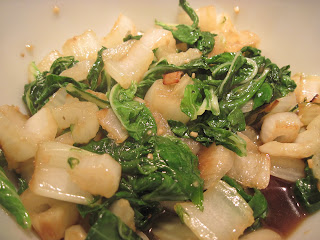 1 small head of cabbage, cut into small pieces and cored
1 small head of cabbage, cut into small pieces and cored1 cup of chopped onions
1 tablespoon butter
1 1/2 cup of milk (I used unsweetened almond milk)
4 tablespoons goat cheese
4 eggs, beaten
1/3 cup bread crumbs (I used rice bread crumbs)
1 tsp dried basil
1 tsp garlic powder
Dried oregano
Parmesan cheese
Salt to taste
Pre-heat oven to 350.
Melt butter in large frying pan over medium heat. Add in cabbage and onion, and cook for about 10-15 minutes, stirring frequently, until softened. Meanwhile, beat 4 eggs in a small bowl.
Add in milk and cheese. Cook for approximately another 5 minutes, until milk starts to boil. Slowly add the beaten eggs to the vegetable and milk mixture, stirring as you pour in the egg. Add in bread crumbs, basil, salt and garlic powder. Cook for another 5 minutes.
Put mixture into a small casserole dish. Sprinkle top with dried oregano, parmesan cheese and a few tablespoons of bread crumbs. Put into oven and bake for about 15-20 minutes, until bread crumbs on top begin to brown.



